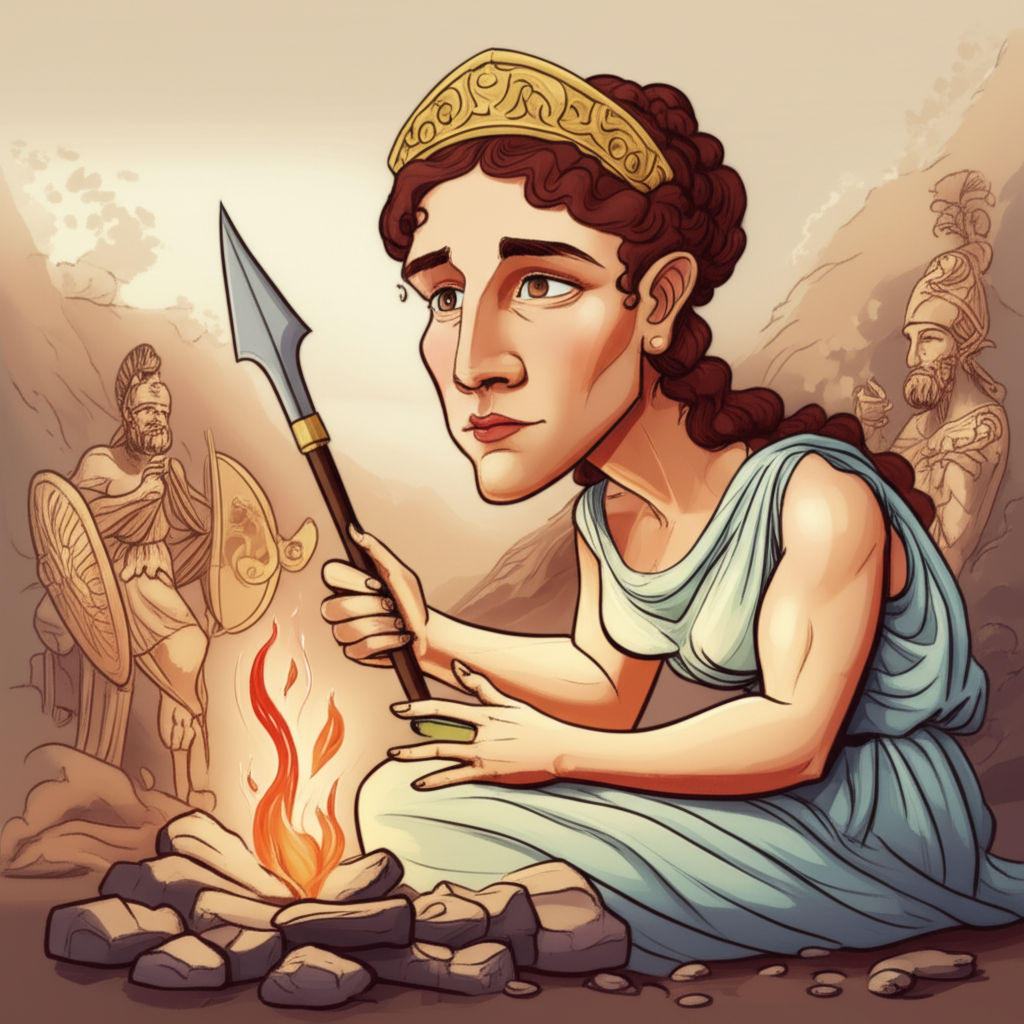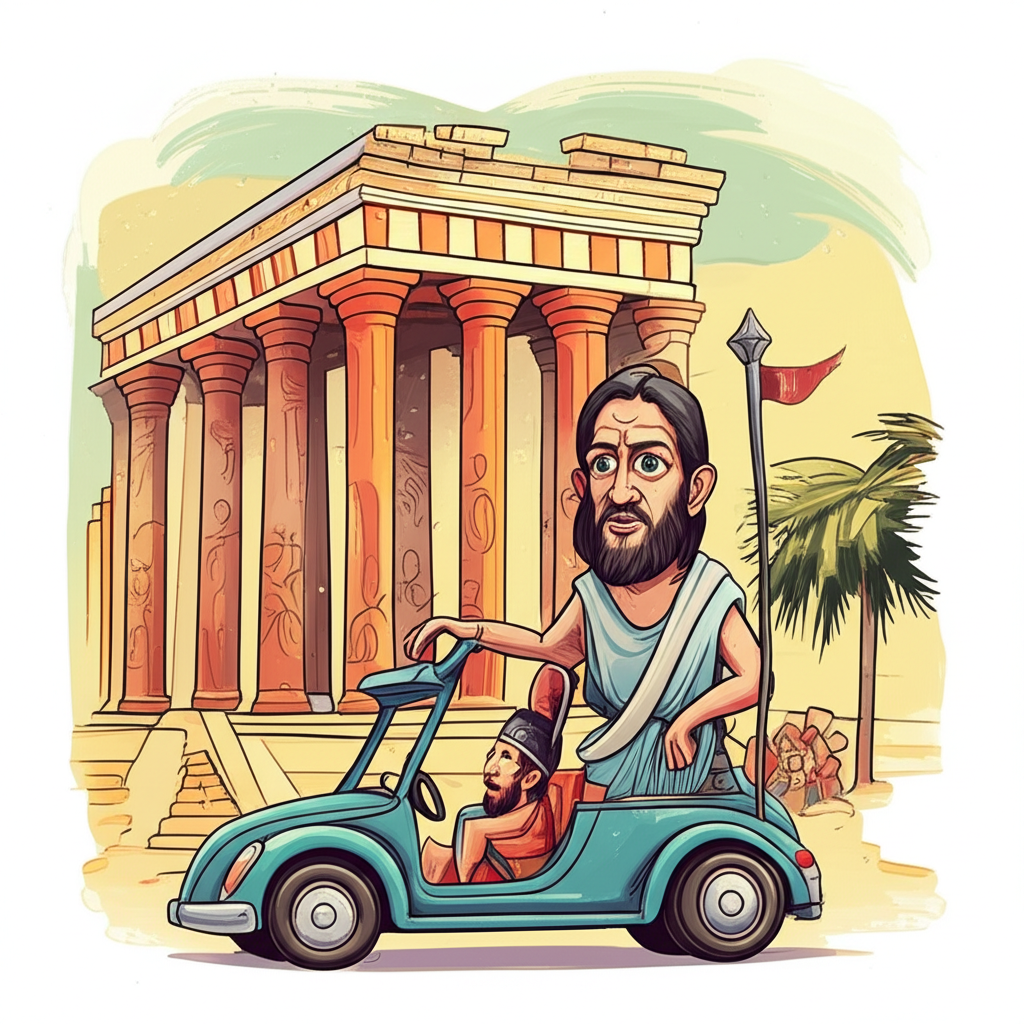
1. Introduction
The rich tapestry of ancient Greek mythology offers a fascinating window into the worldview of a civilization that shaped much of Western thought. These compelling narratives, passed down through generations, served not as historical accounts but as explanations for the inexplicable, moral lessons, and reflections of societal values. Among these traditional stories is the epic struggle known as the Gigantomachy – the War of the Giants – a cataclysmic conflict that solidified the reign of the Olympian gods. Within this grand narrative of cosmic warfare, one figure often stands apart in her quiet steadfastness: Hestia, the goddess of the hearth. This article delves into this ancient Greek legend, exploring its cultural context, the roles of its key figures, and the profound symbolism it carried for the people who told it.
2. Origins and Cultural Background
This particular myth originates from the heart of ancient Greece, a land of independent city-states, burgeoning philosophy, and profound artistic expression. The cultural era in which these myths flourished, particularly during the Archaic and Classical periods (roughly 800 BCE to 300 BCE), saw the development of a complex polytheistic religion that permeated every aspect of life. For the ancient Greeks, the world was not a sterile, mechanical place but a vibrant, living entity, teeming with divine beings, powerful spirits, and the ever-present hand of fate.
They viewed the world as a dynamic stage where gods, goddesses, titans, and monstrous beings interacted, often with dramatic and far-reaching consequences for humanity. Natural phenomena – the changing seasons, the fury of a storm, the fertility of the land – were attributed to the actions and moods of the gods. Morality, justice, and societal order were often seen as divine mandates, and the myths provided a framework for understanding human struggles, triumphs, and the consequences of hubris. The Gigantomachy, following the earlier Titanomachy (the war against the Titans), represented a critical phase in the establishment of cosmic order, moving from primeval chaos to a more structured, albeit still volatile, divine hierarchy.
3. Character / Creature Description
To fully appreciate the Gigantomachy, one must understand its central players.
Hestia: As one of the twelve Olympian gods, Hestia holds a unique position. She is the eldest child of Cronus and Rhea, making her a sibling to Zeus, Poseidon, Hades, Demeter, and Hera. Unlike her boisterous and often interventionist siblings, Hestia is characterized by her tranquility and unwavering dedication to her sacred duties. She is the goddess of the hearth, home, domesticity, and family. Her symbolic attributes are primarily the eternal flame, which she tends in the hearth of every home and, most importantly, in the central hearth of Olympus itself. She is depicted as a veiled, serene figure, often holding a branch or a kettle. Hestia vowed eternal virginity, a choice that underscored her commitment to the purity and sanctity of the domestic sphere. She represents stability, continuity, and the warm, welcoming heart of both the individual household and the community. Her quiet, grounding presence is a stark contrast to the often-turbulent world of the other Olympians.
The Giants (Gigantes): The adversaries in this great war were the Gigantes, monstrous beings born from Gaea (Earth) in her rage over the imprisonment of her earlier children, the Titans, in Tartarus. These colossal figures were the embodiment of primal, untamed nature. Descriptions of the Gigantes vary, but they are consistently portrayed as immensely powerful, often with human torsos and serpentine lower bodies, rooted to the earth from which they sprang. Their strength was immense, capable of tearing mountains from their foundations. Each Giant possessed unique characteristics, but collectively, they represented a formidable, chaotic force, a direct challenge to the burgeoning order of the Olympian gods. They were the raw, elemental power of the earth, rising to reclaim dominance against the sky-dwelling gods.
4. Main Story / Narrative Retelling
According to ancient Greek myths, after the Olympian gods, led by Zeus, had vanquished the elder Titans and imprisoned them in the deepest abyss of Tartarus, a new era of divine rule dawned. Zeus, Poseidon, and Hades divided the cosmos among themselves, establishing their dominion over the sky, sea, and underworld, respectively, while the other Olympians took their places on Mount Olympus. Yet, the Earth Mother, Gaea, still seethed with resentment over the fate of her children. From her fertile, indignant depths, she birthed a new race of monstrous beings: the Gigantes.
These Giants, born of the earth and infused with raw, primordial power, were destined to challenge the Olympians for cosmic supremacy. Their forms were colossal, their strength immense, and many were depicted with scaly legs or serpentine lower halves, tethering them to the very soil from which they arose. Prophecy foretold that the Giants could not be defeated by the gods alone; a mortal hero was required to fight alongside them. Thus, Heracles, the mightiest of mortals, was summoned to aid the Olympians.
The Gigantomachy erupted with earth-shattering fury. The Gigantes, led by powerful figures like Alcyoneus, Porphyrion, and Enceladus, launched a direct assault on Mount Olympus. They tore up mountains, piling them one upon another, attempting to scale the divine abode and overthrow the Olympian gods. The skies darkened with hurled boulders, and the earth groaned under the weight of the titanic struggle.
Zeus, wielding his thunderbolts, led the charge, his lightning illuminating the chaos. Poseidon, trident in hand, summoned earthquakes and tidal waves to buffet his foes. Athena, goddess of wisdom and strategic warfare, fought with fierce intellect and unmatched skill. Apollo rained arrows from afar, while Artemis, his twin, pursued Giants with her deadly bow. Hephaestus, the smith god, forged divine weapons and set traps of fire. The roar of battle echoed across the cosmos as gods and Giants clashed in a struggle for the very fabric of existence.
Amidst this cataclysmic conflict, the figure of Hestia offers a poignant contrast. While her siblings and their allies engaged in desperate, brutal combat, Hestia remained on Mount Olympus, tending to the sacred, eternal flame of the divine hearth. She did not wield a weapon, nor did she engage in direct combat. Her presence was one of quiet endurance and unwavering commitment to her duties. She was the anchor, the calm center amidst the storm, the embodiment of the home and order that her siblings were fighting to protect. While the Giants sought to dismantle the established world, Hestia represented the sanctity and stability of that world, the very essence of what the Olympians were striving to preserve. Her quiet steadfastness was a silent testament to the enduring value of peace and the domestic sphere, the very things threatened by the chaos of the Gigantes.
With the crucial aid of Heracles, who struck the mortal blows that the gods alone could not deliver, the tide of the war slowly turned. One by one, the mighty Gigantes were defeated, some buried beneath the very mountains they had hurled, others cast into Tartarus. The great war ended with the triumph of the Olympians, solidifying their rule and restoring cosmic order.
5. Symbolism and Meaning
To the ancient Greeks, the Gigantomachy was more than just an exciting tale of divine combat. It was a profound allegory, rich with symbolism. The war represented the eternal struggle between order (cosmos) and chaos (chaos). The Olympian gods, with their established hierarchy, laws, and distinct domains, embodied the principles of order and civilization. The Gigantes, born of the raw, untamed earth, represented primeval, destructive chaos, a challenge to any structured existence. Their defeat signified the triumph of intellect, strategy, and divine law over brute force and elemental anarchy. It also reinforced the idea of divine authority and the establishment of a stable cosmic order after the earlier, equally chaotic Titanomachy.
Hestia’s role, or rather her non-role in direct combat, is particularly significant. She symbolizes the sanctity and enduring importance of the home, family, and community hearth. While other gods battled on the front lines, Hestia’s unwavering presence at the Olympian hearth represented the core values that were being defended. She embodied the peace, stability, and domestic harmony that the Gigantes threatened to obliterate. Her steadfastness underscored the idea that even amidst the greatest conflicts, there are foundational elements of life—home, warmth, belonging—that must be preserved and cherished. She was the quiet strength, the unmoving center, reminding all of what they were fighting for.
6. Modern Perspective
Today, the myths of ancient Greece, including the Gigantomachy and the figure of Hestia, continue to resonate across various cultural landscapes. In literature, these stories provide archetypal characters and narrative structures. The theme of order versus chaos, so central to the Gigantomachy, is a timeless motif explored in countless novels, plays, and poems. Hestia’s quiet strength and dedication to home offer an alternative perspective on heroism, one rooted in preservation and stability rather than conquest.
In modern media, Greek mythology frequently appears in movies, television series, and video games. Blockbusters like Clash of the Titans and the Percy Jackson series draw heavily from these narratives, often reimagining the gods and their conflicts for contemporary audiences. The visual spectacle of the Gigantomachy, with its colossal battles and divine powers, lends itself perfectly to cinematic adaptation. Academically, cultural studies and classical scholarship continue to analyze these myths, not as literal truth, but as invaluable insights into the psychology, sociology, and religious practices of ancient societies. They reveal fundamental human concerns about power, justice, family, and the search for meaning in a complex world.
7. Conclusion
The narrative of Hestia and the War of Gigantomachy stands as a powerful testament to the enduring human capacity for storytelling. It is a cultural narrative, a product of the ancient Greek imagination, shared and revered by a people striving to understand their world and their place within it. It is important to reiterate that these stories are part of mythology and folklore; they are not real and are not meant to be believed, worshipped, or practiced as a divine truth.
As Muslims, we recognize that only Allah is the true Creator and Sustainer, the One without peer or partner, and the Source of all true power and order in the universe. We affirm that Allah is the Most High, and there is no god but He.
Nevertheless, the study of such cultural narratives enriches our understanding of human heritage. They reflect the fears, hopes, and moral frameworks of civilizations long past, reminding us of the universal threads that connect humanity through imagination and shared narratives across different eras and beliefs. The quiet steadfastness of Hestia amidst the colossal struggle of the Gigantomachy remains a vivid image, a reminder of the enduring power of the home and the spirit that protects it, even in the grandest cosmic battles of imagination.





